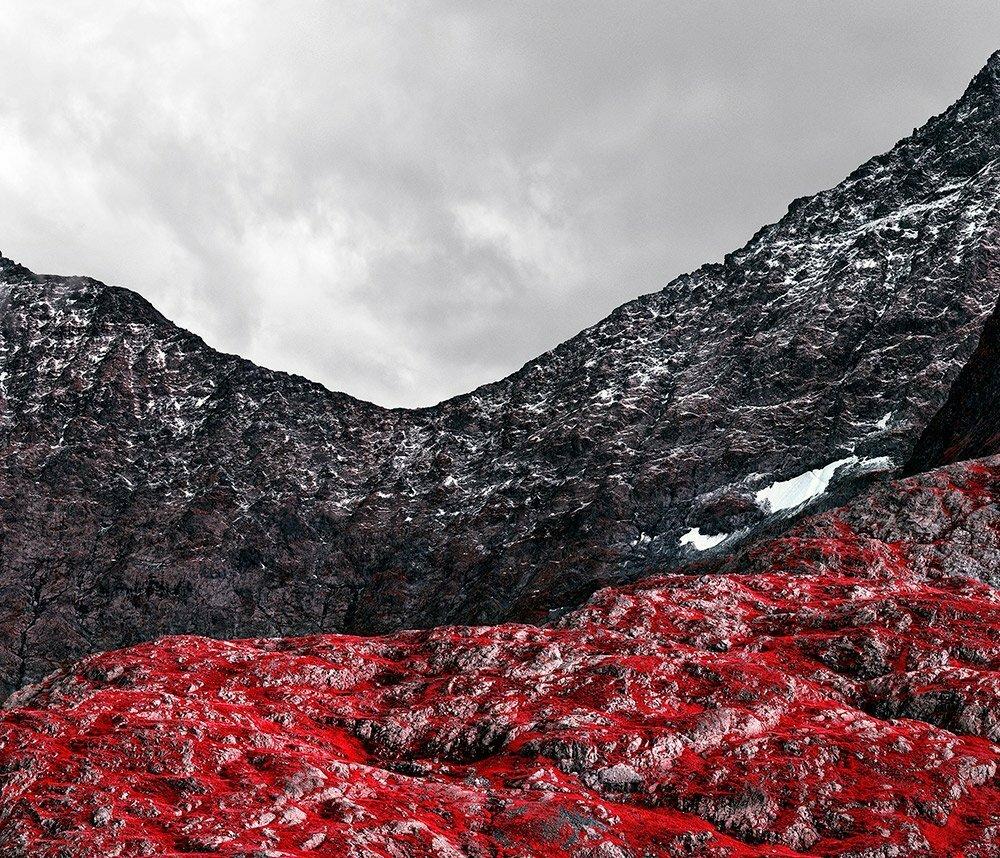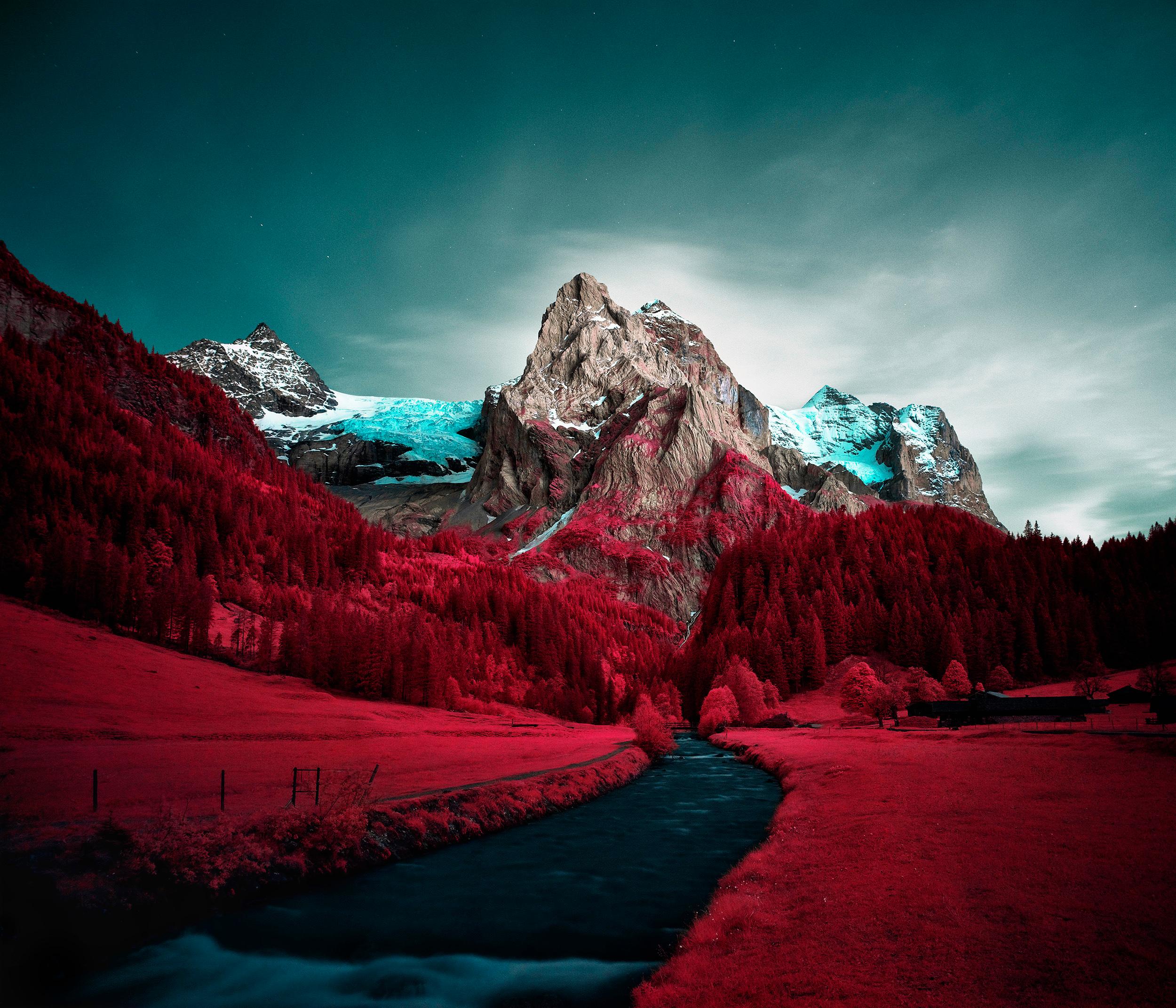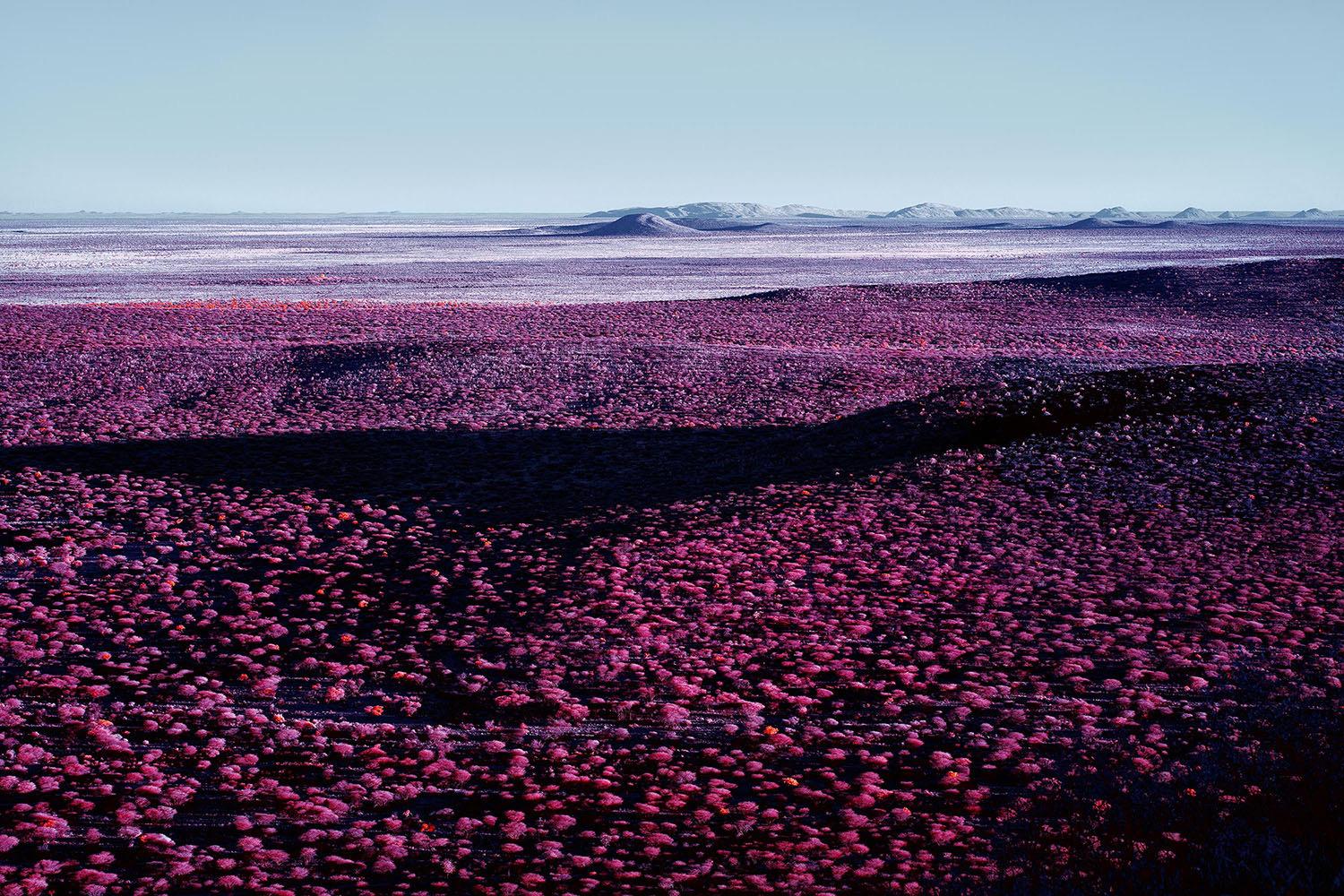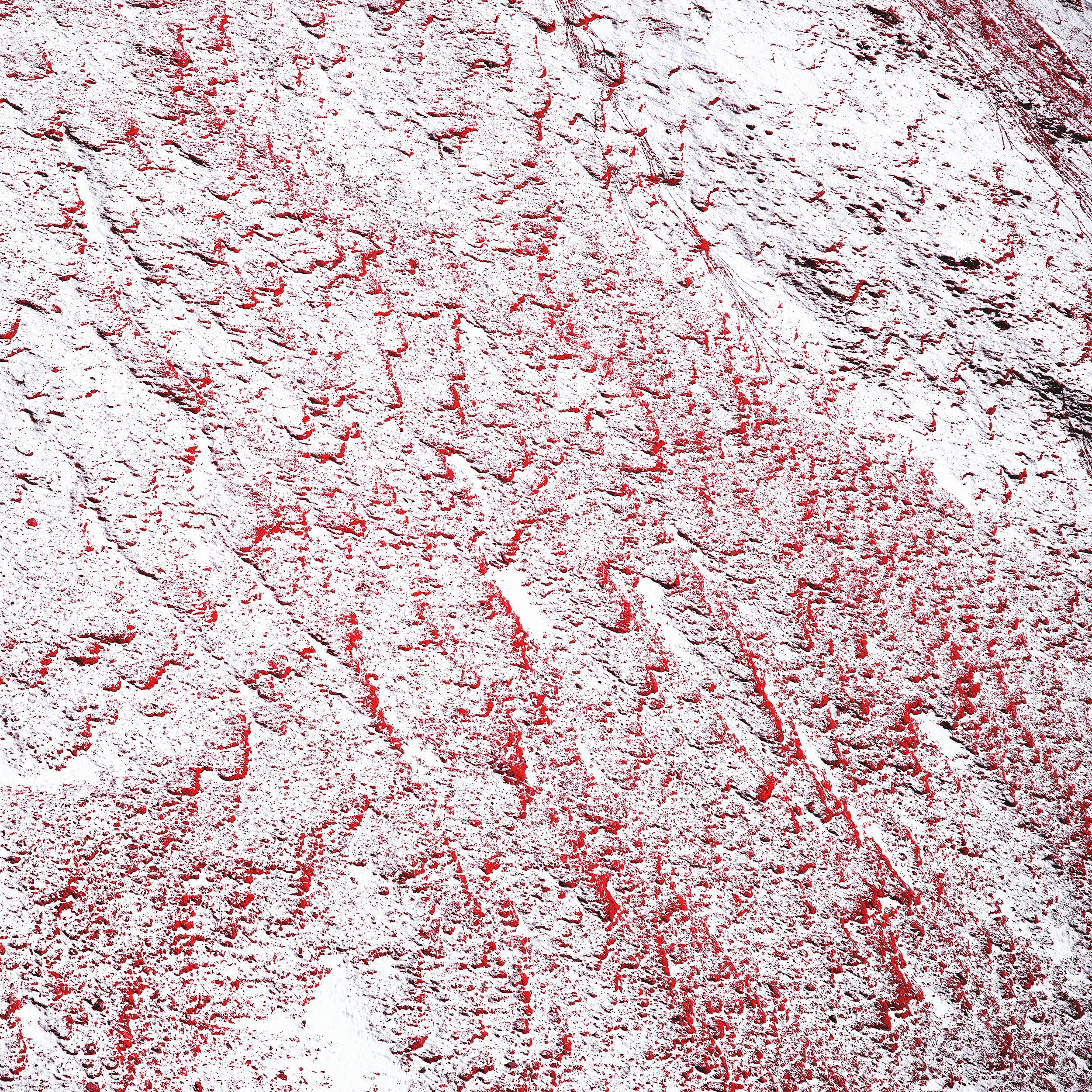Want more images or videos?
Request additional images or videos from the seller
1 of 5
Zak van BiljonMeteora, Greece2018
2018
About the Item
Meteora, Greece
2018
Edition 1/5.
Pigment print on Canson photographic rag 310g, mounted on dibond in smoked oak wood frame with museum glass.
Framed: 35 x 39 x 3 cm
To get a fresh look at natures beauty in a modern era, Zak van Biljon went beyond the visible spectrum to capture these vivid images.
The technique, developed for military surveillance and crop surveys, captures near-infrared light: wavelengths of electromagnetic radiation that fall between what we see as red and the longer wavelengths used for thermal imaging.
The pigment in plant leaves, chlorophyll, strongly absorbs visible light which they use as a source of energy in the process of photosynthesis.
The cell structure of the leaves, on the other hand, strongly reflects near-infrared light. A strong absorption at these wavelengths would only result in overheating the plant and possibly damaging the tissues. The human eye is unable to perceive infrared light but it is exactly this reflected energy, which reacts with infrared-sensitive material to create electric pinks and vibrant reds.
The idea of landscapes is not landscape by itself. Nothing exists by itself but only through perception. Our perception, however, is subject to both individual watching and classifying what we see.
The classification is strongly subdued to the imagery with which we are confronted every day. The famous Windows computer desktop image “Bliss” and others of this kind have become a kind of nature of which we believe that is is “true” nature.
Pictures of natures are not about falsifying nature itself but are reflecting our perception of nature. What kind of image do we have? On social media channels user are sharing zillions of filtered photos of nature – or what they think nature must look like.
- Creator:Zak van Biljon (1981, South African, Swiss)
- Creation Year:2018
- Dimensions:Height: 13.78 in (35 cm)Width: 15.36 in (39 cm)Depth: 1.19 in (3 cm)
- Medium:
- Movement & Style:
- Period:
- Condition:
- Gallery Location:Berlin, DE
- Reference Number:1stDibs: LU2647213202172
Red turf is the homeland of Zak van Biljon. The South African photographer, born in 1981, spent his childhood and teenage years in both Johannesburg and Cape Town. 2003 he graduated as the best student at the National College of Photography. With a study of black & white printing – ironically, for someone who grew up under the colorful impressions of the Rainbow Nation. In 2004 he left the country and emigrated to Europe. It was in Rome, that he discovered another sunlight, and in London, where he scored himself on top of booking lists for prestigious underground labels. He continued his career as a part-time commercial photographer in Zurich, Switzerland, exerting his mastery of his fine art projects. His work ranges from digital to analog with skills in contemporary advertising and modern art photography. His main focus is the directorial handling of light – as shown in his recent artwork, capture the world in infrared. The world seen in red and pink colors provides a new and impressive insight to reality as we know it. I am from South Africa where I grew up in nature. In fact, I had only seen a neighbor for the first time when I was 12 years old. Nature is important to me and I really like the outdoors where I do hiking or rock climbing. When it comes to my photography, I like to learn more by exploring. My first camera was a disposable camera which I took along on our first family trip to Namibia.
He started with black and white infrared photography In 2001. The popularization of infrared photography started in the 1960s. A number of recording artists, including Jimi Hendrix and Frank Zappa, made use of the technique on their album covers. The CD cover of Bob Dylan attracted my attention. Later, he tried color infrared photography in 2009 and I really love the way it presents.
Zak always loved landscape photography. He admits that his father is a hobby photographer who inspired him a lot. Since the artist has been exposed to different cultures, the various social environments influenced me as well.
About the Seller
No Reviews Yet
Vetted Seller
These experienced sellers undergo a comprehensive evaluation by our team of in-house experts.
1stDibs seller since 2023
- ShippingRetrieving quote...Ships From: Berlin, Germany
- Return PolicyThis item cannot be returned.
More From This SellerView All
- SustenjochLocated in Berlin, DESustenjoch 2020 Edition of 2. Pigment print on Canson photographic rag 310g, mounted on dibond in smoked oak wood frame with museum glass. Framed: 68 x 76 x 3 cm Other Edition in 3 sizes, 3-2-1 + AP To get a fresh look at natures beauty in a modern era, Zak van Biljon went beyond the visible spectrum to capture these vivid images. The technique, developed for military surveillance and crop surveys, captures near-infrared light: wavelengths of electromagnetic radiation that fall between what we see as red and the longer wavelengths used for thermal imaging. The pigment in plant leaves, chlorophyll, strongly absorbs visible light which they use as a source of energy in the process of photosynthesis. The cell structure of the leaves, on the other hand, strongly reflects near-infrared light. A strong absorption at these wavelengths would only result in overheating the plant and possibly damaging the tissues. The human eye is unable to perceive infrared light but it is exactly this reflected energy, which reacts with infrared-sensitive material to create electric pinks and vibrant reds. The idea of landscapes is not landscape by itself. Nothing exists by itself but only through perception. Our perception, however, is subject to both individual watching and classifying what we see. The classification is strongly subdued to the imagery with which we are confronted every day. The famous Windows computer desktop image “Bliss” and others of this kind have become a kind of nature of which we believe that is “true” nature. Pictures of natures are not about falsifying nature itself but are reflecting our perception of nature. What kind of image do we have? On social media channels user are sharing zillions of filtered photos of...Category
2010s Naturalistic Landscape Photography
MaterialsPigment, Rag Paper
- Dammagletscher UriLocated in Berlin, DEDammagletscher Uri 2020 Edition 1, AP. Pigment print on Canson photographic rag 310g, mounted on dibond in smoked oak wood frame with museum glass. Framed: 144 x 128 x 7 cm. Other ...Category
2010s Naturalistic Landscape Photography
MaterialsRag Paper, Pigment
- RothkoLocated in Berlin, DERothko 2020 Edition 1, AP. Pigment print on Canson photographic rag 310g, mounted on dibond in grey oak wood frame with museum glass. Framed: 144.6 x 128 x 7 cm Other editions in 3 ...Category
2010s Naturalistic Landscape Photography
MaterialsRag Paper, Pigment
- Wetterhorn, BernLocated in Berlin, DEWetterhorn, Bern 2020 Edition on 2 Pigment print on Canson photographic rag 310g, mounted on dibond in smoked oak wood frame with museum glass. Framed: 68 x 76 x 3 cm Other edition in 3 sizes, 3-2-1 + AP To get a fresh look at natures beauty in a modern era, Zak van Biljon went beyond the visible spectrum to capture these vivid images. The technique, developed for military surveillance and crop surveys, captures near-infrared light: wavelengths of electromagnetic radiation that fall between what we see as red and the longer wavelengths used for thermal imaging. The pigment in plant leaves, chlorophyll, strongly absorbs visible light which they use as a source of energy in the process of photosynthesis. The cell structure of the leaves, on the other hand, strongly reflects near-infrared light. A strong absorption at these wavelengths would only result in overheating the plant and possibly damaging the tissues. The human eye is unable to perceive infrared light but it is exactly this reflected energy, which reacts with infrared-sensitive material to create electric pinks and vibrant reds. The idea of landscapes is not landscape by itself. Nothing exists by itself but only through perception. Our perception, however, is subject to both individual watching and classifying what we see. The classification is strongly subdued to the imagery with which we are confronted every day. The famous Windows computer desktop image “Bliss” and others of this kind have become a kind of nature of which we believe that is is “true” nature. Pictures of natures are not about falsifying nature itself but are reflecting our perception of nature. What kind of image do we have? On social media channels user are sharing zillions of filtered photos of nature...Category
2010s Naturalistic Landscape Photography
MaterialsRag Paper, Pigment
- Kalakwa 1, Khomas RegionLocated in Berlin, DEKalakwa 1, Khomas Region, 2018 Edition of 2 Pigment print on Canson photographic rag 310g, mounted on dibond in smoked oak wood frame with museum glass. Framed: 68 x 93 x 3 cm Other editions in 3 sizes, 3-2-1 + AP To get a fresh look at natures beauty in a modern era, Zak van Biljon went beyond the visible spectrum to capture these vivid images. The technique, developed for military surveillance and crop surveys, captures near-infrared light: wavelengths of electromagnetic radiation that fall between what we see as red and the longer wavelengths used for thermal imaging. The pigment in plant leaves, chlorophyll, strongly absorbs visible light which they use as a source of energy in the process of photosynthesis. The cell structure of the leaves, on the other hand, strongly reflects near-infrared light. A strong absorption at these wavelengths would only result in overheating the plant and possibly damaging the tissues. The human eye is unable to perceive infrared light but it is exactly this reflected energy, which reacts with infrared-sensitive material to create electric pinks and vibrant reds. The idea of landscapes is not landscape by itself. Nothing exists by itself but only through perception. Our perception, however, is subject to both individual watching and classifying what we see. The classification is strongly subdued to the imagery with which we are confronted every day. The famous Windows computer desktop image “Bliss” and others of this kind have become a kind of nature of which we believe that is is “true” nature. Pictures of natures are not about falsifying nature itself but are reflecting our perception of nature. What kind of image do we have? On social media channels user are sharing zillions of filtered photos of nature...Category
2010s Naturalistic Landscape Photography
MaterialsRag Paper, Pigment
- Furka 1. UriLocated in Berlin, DEFurka 1, Uri, 2021 Edition of 3 Pigment print on Canson photographic rag 310g, mounted on dibond in smoked oak wood frame with museum glass. Framed: 53 x 53 x 3 cm Other editions i...Category
2010s Naturalistic Landscape Photography
MaterialsPigment, Rag Paper
You May Also Like
- Foggy Morning Pines (Hand-Printed original cyanotype, 24 x 18 inches)Located in Oakland, CAHand-printed original cyanotype photograph on watercolor paper. Actor Timothée Chalamet owns one edition of this photo, though his is a mirror image printed from the only time that t...Category
2010s Naturalistic Landscape Photography
MaterialsRag Paper, Photogram
- Rest - An East Hamptons beach storm and seabirdsBy Jean- Michel LenoirLocated in New York, NY49" x 70" Ed. of 8 $9,800 & larger 41" x 59" Ed. of 10 $6,800 36" x 50" Ed. of 6 $5,200 30" x 42" Ed. of 6 $3,600 Recommended option to use museum glass/acrylic priced on request In this photograph, Lenoir captures a calming seascape featuring a group of piping plovers on East Hamptons beach...Category
2010s Naturalistic Landscape Photography
MaterialsGlass, Paper, Archival Paper, Photographic Paper, Color, Pigment, Archiv...
- Louse Point, East Hampton, Abstract Photography in Green and BeigeBy Mitchell FunkLocated in Miami, FLSigned, dated numbered Edition 2 of 15, lr verso - Other sizes available, Printed Later. Unframed, Printed on Hahnemühle Fine Art paperCategory
2010s Naturalistic Landscape Photography
MaterialsPhotographic Paper, Archival Ink, Archival Paper, Archival Pigment
- Emergence IBy Jean- Michel LenoirLocated in New York, NYA resolutely minimalist and suggestive approach to get to the essential. Not trying to show a subject for what it is, but for what it expresses. This is my way of telling stories, of...Category
2010s Naturalistic Landscape Photography
MaterialsArchival Paper, Archival Ink, Photographic Paper, Archival Pigment
- Tumult IIBy Jean- Michel LenoirLocated in New York, NYTumult II 30" X 42" Ed. of 10, Unframed $3,600 Framing options range from $400 to $800 Also available in 40*60" A resolutely minimalist and suggestive approach to get to the essen...Category
2010s Naturalistic Landscape Photography
MaterialsArchival Paper, Digital Pigment, Pigment, Archival Ink, Photographic Pap...
- ElevationBy Jean- Michel LenoirLocated in New York, NYElevation 30" X 42" Ed. of 10, Unframed we can frame it in a white wood shadow box. The frame price is 400$. A resolutely minimalist and suggestive approach to get to the essential....Category
2010s Naturalistic Landscape Photography
MaterialsArchival Paper, Digital Pigment, Archival Ink, Photographic Paper, Archi...






